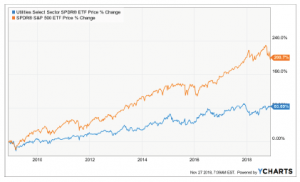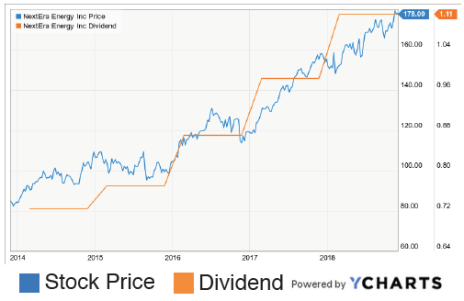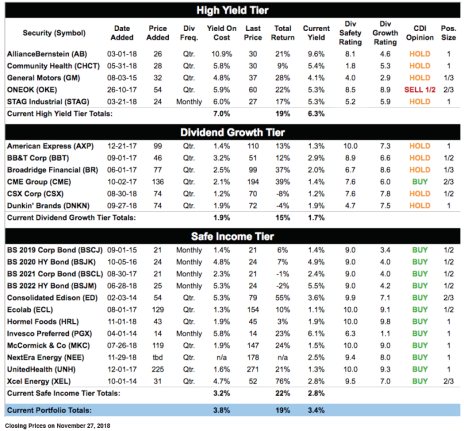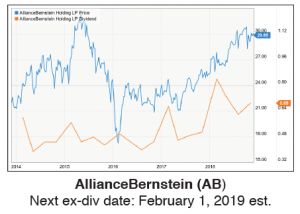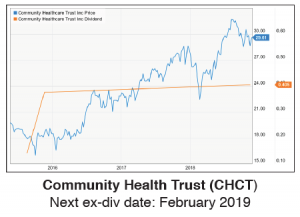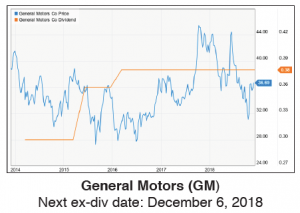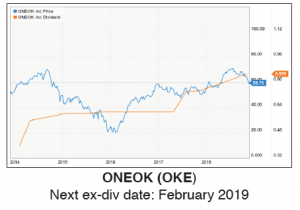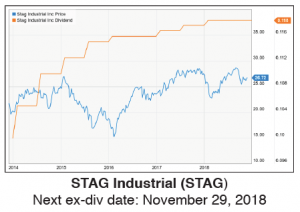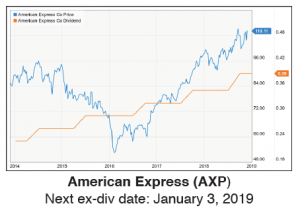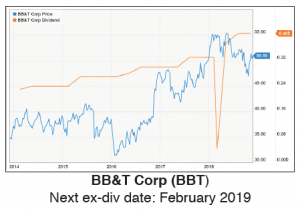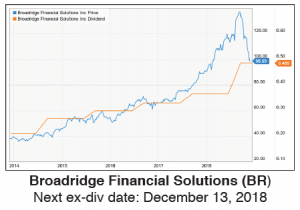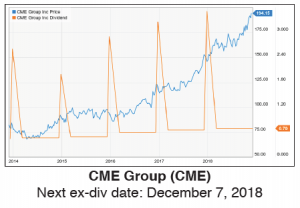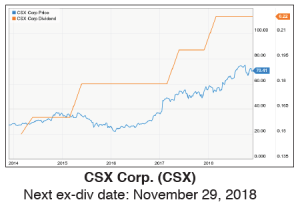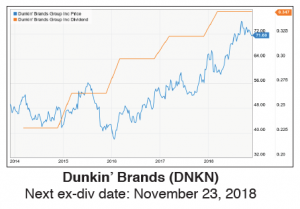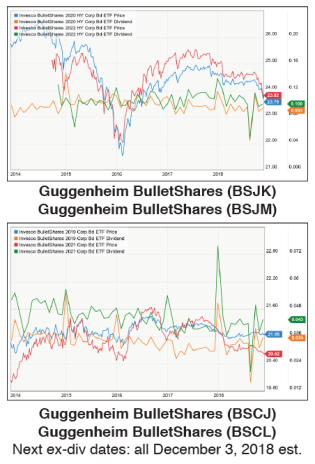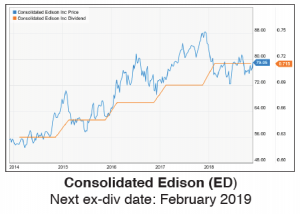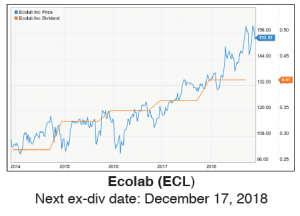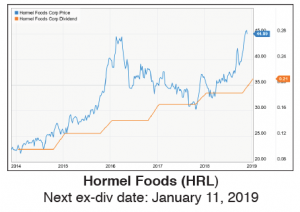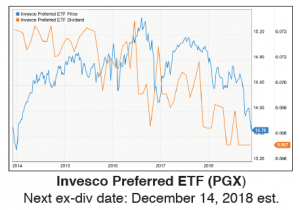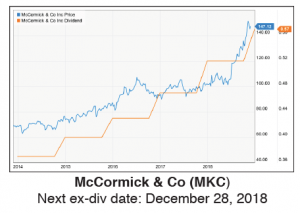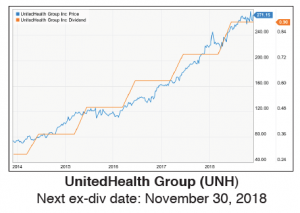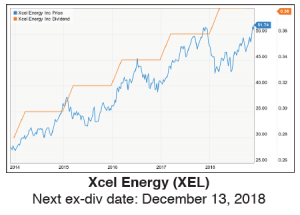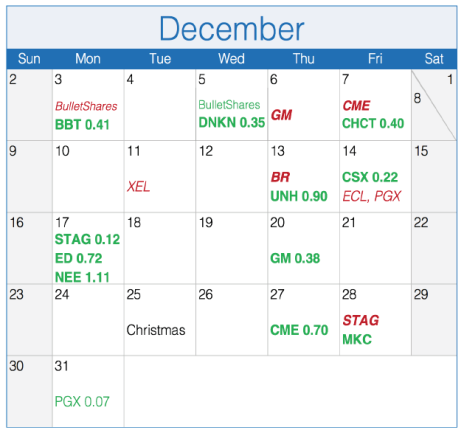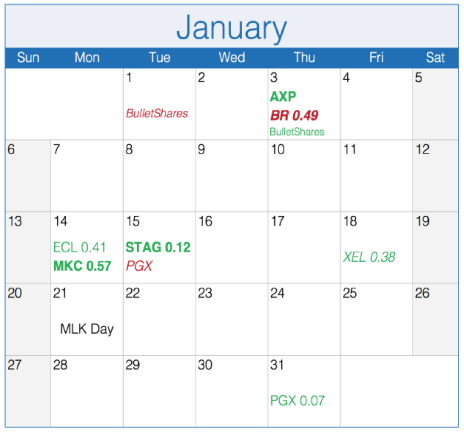In today’s issue, I’m adding one more utility to the Safe Income tier. The Fed wants to keep the conversation about rate hikes going—four Fed members are giving speeches this week, including Chair Jerome Powell later today—but markets believe that rates are rapidly approaching “neutral.” In a speech on Tuesday, Vice Chair Richard Clarida said the Fed needs to be even more data dependent as the benchmark rate nears its “ultimate destination,” rather than committing to a certain number of rate hikes.
Elsewhere, our Safe Income stocks are all doing well, and most of our Dividend Growth and High Yield holdings are looking healthy as well. And at the end of today’s issue, I’ve provided a watch list of some stocks on my radar for addition to the portfolio.
Cabot Dividend Investor 1118
[premium_html_toc post_id="165007"]
Approaching Neutral
The major stock market indexes tacked on more losses last week, even though markets were only open for three-and-a-half days and trading was relatively light. The Nasdaq closed the week 4.3% lower, the Dow was down 4.4%, and the S&P 500 lost 3.8%. But the market has stabilized this week, as investors prepare for the last month of the year.
And although all sectors were lower last week, utilities and REITs held up relatively well. Consumer staples and health care stocks also posted smaller losses than other stocks. The biggest losers were tech stocks, again, and energy stocks. Oil prices fell 11% last week, including a nearly 8% drop on Friday alone.
The correction in stocks and oil prices over the past month has increased demand for treasuries, driving down yields. And while the Fed is still expected to raise their benchmark rate in December (odds in the futures market have risen to 79%), market watchers expect the hikes to slow next year as rates approach neutral. Futures markets are currently pricing in a less than 40% chance of another hike by the Fed’s March meeting, and there’s a good chance we’ll only get one hike next year. That will provide a nice backdrop for interest rate sensitive investments, as well as the broader market.
[highlight_box]What To Do Now: The market has stabilized a bit, and I’m moving the rest of our Safe Income holdings back to Buy: Ecolab (ECL) and UnitedHealth (UNH). Riskier investments are still in limbo though, and in the high yield tier I’m selling another third of our ONEOK (OKE) shares, due to the stock’s continued decline.[/highlight_box]
Featured Buy
NextEra Energy (NEE)
There’s a reason income investors like utilities. Although these regulated monopolies will never grow as fast as tech stocks or small caps, they make great long-term holdings. A long-term chart of the utilities sector vs. a broad market index shows that these stocks lose much less during drawdowns (they can even be counter-cyclical) and trend up gradually over the long term. Best of all, utilities are the textbook example of safe income stocks, with their reliable income streams leading many to have increased their dividends every year for decades.
Of course, the stocks can be sensitive to changes in interest rates, and the sector has become more volatile since the Fed started raising rates in 2015. But while utilities have pulled back ahead of most of the Fed’s rate hikes, all the retreats have been temporary. And with the Fed’s benchmark rate rapidly approaching neutral, now is a good time to be adding long-term exposure to utilities. So today I’m adding a new utility stock to the portfolio for the first time since we bought Xcel Energy (XEL) in October 2014.
The Company
NextEra Energy isn’t your typical utility stock. Founded as Florida Power & Light back in the 1920s, the company traded under the ticker symbol FPL for nearly six decades. The company’s regulated utility subsidiary is still called FPL and still provides electricity to the most populous parts of Florida. About 46% of FPL’s energy comes from natural gas, 26% from nuclear and 22% from wind. Revenues are stable, regulated and grow steadily along with Florida’s population.
But FPL started branching out into renewable energy projects—mostly outside Florida—in the 1990s, and the business got big enough that the company changed its name to NextEra Energy in 2010 (and started trading under the current ticker NEE). NextEra owns wind and solar installations in 35 states and Canada, as well as battery storage sites, natural gas pipelines and a handful of nuclear plants. About 69% of the division’s energy comes from wind, 14% from nuclear and 11% from solar. The company says it’s the world’s largest generator of renewable power.
NextEra’s renewable power business now brings in between a quarter and a third of operating revenues, and is growing much faster than the utility business. Overall, the company’s EPS have grown by 20% per year, on average, in each of the last five years. Analysts expect EPS to grow by another 16% this year and 8% next year. And NextEra has a huge backlog of projects—mostly wind and solar—already approved that should continue to drive growth into the future.
In 2014, NextEra also launched a yieldco, called NextEra Energy Partners, to acquire and own contracted renewable energy projects with stable cash flows. The yieldco can buy assets from its parent company or other sources, as long as their output is already leased to a creditworthy counterparty under a long-term contract. (If you’re more income- than growth-oriented, NextEra Energy Partners, which trades under the symbol NEP and yields 3.7%, is a solid investment in its own right.) This combination of businesses opens up a variety of financing options for NextEra, and the company’s debt load is reasonable for a utility.
The Dividend
NextEra also pays a reliable dividend, and currently yields about 2.5%. The company has paid dividends every year since 1983, and has increased the dividend every year since 2005. The current payout ratio is reasonable, at 57%. And there’s growth ahead, too—management anticipates dividend hikes of around 13% annually for at least the next couple of years. Combined with analysts’ earnings growth expectations, NextEra’s dividend history earns the stock a Dividend Safety Rating of 9.4 and a Dividend Growth Rating of 8.0 from IRIS.
The Stock
NEE is in a steady, long-lived uptrend, and is trading near 52-week highs. The stock spent most of August, September and October consolidating between 165 and 175. NEE broke out of that range to the upside in early November, and a quick run to new all-time highs followed. The stock is now pulling back from its highs just slightly, and can be bought here for long-term growth and safe income. I’ll be adding it to the Safe Income Tier at tomorrow’s average price.
| NextEra Energy (NEE) | ||
|---|---|---|
| Price: 177.10 52-week range: 183.65-145.10 Market cap: $84.64 billion P/E: 11 | Current yield: 2.5% Annual dividend: $4.44 Most recent dividend: $0.11 Dividend Safety rating: 9.4 Dividend Growth rating: 8.0 | |
| Dividends since: 1983 Consecutive years of increases: 13 Qualified dividends? Yes | Payment Schedule: Quarterly Next ex-dividend date: November 29, 2018 | |
Portfolio at a Glance
Portfolio Updates
High Yield Tier
The investments in our High Yield tier have been chosen for their high current payouts. These ?investments will often be riskier or have less capital appreciation potential than those in our other ?two tiers, but they’re appropriate for investors who want to generate maximum income from their? portfolios right now.
HOLD – AllianceBernstein (AB 30 – yield 9.6%) – AB continues to hold up pretty well, taking the Thanksgiving-week selling in stride and closing above its 50-day yesterday. The stock is range-bound for now, but has solid support from its 200-day, currently at 28. Assets under management declined in October due to the stock market rout, but net inflows were positive firmwide. AllianceBernstein is a New York-based asset manager that pays variable quarterly distributions based on cash flow. Distributions are considered return of capital and the company issues a K-1 form instead of a 1099. High-yield investors can Hold.
HOLD – Community Health Trust (CHCT 30 – yield 5.4%) – Community Health Trust is a REIT that owns health care buildings in non-urban areas. REITS are benefitting from a decline in interest rates; the 10-year Treasury yield is back to where it was before the Fed’s latest hike at the end of September. Markets still think there’s a good chance of another hike in December, but are starting to anticipate the achievement of “neutral” rates sometime next year—which would mean no more rate hikes for a while. CHCT has solid support from its 200-day moving average, and is trading in a narrowing range around its 50-day yesterday. Hold.
HOLD – General Motors (GM 37 – yield 4.1%) – As you probably saw in the news Monday, GM is closing five U.S. manufacturing plants next year and laying off over 10% of its North American workforce—about 8,000 salaried staff and 5,800 production workers. The news was greeted with mixed emotions by the public, the President, and the press, but investors think it’s the right move. GM closed 4% higher on the day, the stock’s first close above its 200-day line since June. The stock gave back some gains Tuesday after President Trump sent a tweet about cutting subsidies to GM in retaliation, but the company doesn’t currently receive any subsidies from the Federal government. Consumers who purchase electric cars from any automaker, including GM, are eligible for a $7,500 tax credit, but that benefit goes to the consumer, not to the automaker. (And GM is close to hitting the 200,000 electric car milestone at which the subsidies start to decline anyway.) GM will also discontinue some smaller models to focus on more popular and profitable trucks and SUVs as part of its restructuring, which is expected to save the company $6 billion by the end of 2020. The cost savings will help GM fight back against higher tariff costs and waning auto demand in the U.S. Longer-term, GM’s investments in autonomous cars and ridesharing fleets are promising. The stock looks healthy—it gapped up on great volume four weeks ago, built a base around 36, and is now trading at its highest level since July. Hold.
SELL – ONEOK (OKE 60 – yield 5.3%) – OKE looks lousy, and I’m going to sell another half of our shares today (bringing our position down to one-third the normal size). Natural gas prices have surged 32% over the past month, but stocks of natural gas producers haven’t followed suit, suggesting that investors think the bounce is temporary. Unseasonably cold weather eroded natural gas stockpiles in November, but prices were very low to start with, and analysts are predicting they’ll stay low into 2019. I’m going to Sell another third of our shares today, likely for a profit of about 10% (price only). If this is a bottom, we’ll hold the rest and continue enjoying the high yield. If the stock continues lower, we’ll sell the rest next week.
HOLD – STAG Industrial (STAG 27 – yield 5.3%) – STAG has been a good store of value and source of income during the last two months; the stock is trading in a tightening range around 26 and pays dividends monthly. The industrial REIT owns properties in 37 states that are mostly used as warehouses and fulfillment centers. High-yield investors can Hold.
Dividend Growth Tier
To be chosen for the Dividend Growth tier, investments must have a strong history of dividend increases and indicate both good potential for and high prioritization of continued dividend growth.
HOLD – American Express (AXP 110 – yield 1.3%) – AXP has bounced nicely over the past two days, and is back near the top of its trading range. The stock has solid support from its 200-day moving average, currently at 101, and it looks like the 50-day may be beginning to provide support as well. Analysts recently increased their 2018 and 2019 earnings estimates for the credit card company, and now expect AmEx to report 26% EPS growth this year and 10% growth next year. Hold.
HOLD – BB&T Corp (BBT 51 – yield 2.9%) – BBT still looks decent. After bottoming October 29, the stock advanced for three straight weeks, and is now consolidating those gains around 51. BB&T is a large regional bank operating in the mid-Atlantic, Southeast, Midwest and Texas. The company has paid dividends since 1987, has increased the dividend every year since 2011, and has a reasonable 40% payout ratio. Analysts expect BB&T to report 43% EPS growth this year and 10% growth next year. Hold.
HOLD – Broadridge Financial Solutions (BR 99 – yield 2.0%) – I sold another half of our BR shares last Wednesday, at the day’s average price of 99.70, for a 30% profit (price only). I already sold one-third of our shares for a 47% profit back in August, so we’re down to a third of our regular position size in BR. The stock is being dragged down by the selloff in tech stocks—Broadridge provides investor communication solutions and other technology to financial companies. If the stock continues to decline, we’ll sell the rest of our shares. For now, we’ll Hold.
BUY – CME Group (CME 194 – yield 1.4%) – After a brief pullback from its 52-week high last week, CME is rebounding, and still looks buyable. The company runs financial exchanges where traders buy and sell derivatives on everything from equity indexes to interest rates, so revenues rise when market volatility picks up. Nine analysts have increased their 2018 and 2019 earnings estimates over the past month. The stock had a nice long consolidation from March to August, so I don’t think it’s overbought yet. The company pays a large special dividend at the end of each year, which can more than double its normal yield.
HOLD – CSX Corp. (CSX 70 – yield 1.2%) – After a three-week rally, CSX has pulled back a bit and is floating just under its 50-day line. The stock could revisit its 200-day moving average down at 65 again if the market correction continues, but overall CSX still looks healthy. The company is a major freight railroad, whose network stretches from Florida to Montreal and from the Atlantic to the Mississippi. CSX switched to a low-cost point-to-point system last year to increase efficiency, and boasts the lowest costs in the industry. The company has also paid a dividend since 1981, and has increased the dividend for eight years in a row. Hold.
HOLD – Dunkin’ Brands (DNKN 72 – yield 1.9%) – DNKN still looks decent; the stock is chopping around right around its 50-day line, and is still well above its 200-day. Once the market environment improves, this consolidation could provide a good launch pad for the stock’s next advance. Analysts are expecting the coffee and donut chain to report full-year sales growth of 55% and EPS growth of 17%, and management is improving profitability by simplifying menus and focusing on growth areas. DNKN is a Hold.
Safe Income Tier
The Safe Income tier of our portfolio holds long-term positions in high-quality stocks and other investments that generate steady income with minimal volatility and low risk. These positions are appropriate for all investors, but are meant to be held for the long term, primarily for income—don’t buy these thinking you’ll double your money in a year.
BUY – Invesco BulletShares 2019 Corporate Bond ETF (BSCJ 21 – yield 1.4%)
BUY – Invesco BulletShares 2020 High Yield Corporate Bond ETF (BSJK 24 – yield 4.9%)
BUY – Invesco BulletShares 2021 Corporate Bond ETF (BSCL 21 – yield 2.4%)
BUY – Invesco BulletShares 2022 High Yield Bond ETF (BSJM 24 – yield 5.5%)
After a prolonged drop this month, the high yield funds in our bond ladder stabilized over the past week. However, some analysts believe weakness in junk bonds is permanent, citing an end to the “reach for yield” created by low interest rates over the past decade. Higher-quality bonds are now offering yields similar to those available on junk bonds over the past few years, reducing the incentive for investors to move up the credit ladder in search of income. Low oil prices aren’t helping things either: about 15% of junk bond issuers come from the energy sector. Even if junk bonds remain out of favor, the BulletShares funds should be a fairly good store of value, since Invesco disburses the net asset value, or NAV, of the ETF back to investors at expiration.
BUY – Consolidated Edison (ED 79 – yield 3.6%) – On a long-term chart, ED looks very stable, trading in a long sideways range between about 72 and 82. The utility will probably begin to trend up again, albeit gradually, once interest rates level out next year. In the meantime, ED is a good safe haven from market volatility and source of reliable quarterly dividends. The utility is the electricity provider for New York City and the surrounding area. Growth is slow but stable; the utility reported estimate-beating results earlier this month including revenues of $3.33 billion and adjusted EPS of $1.57, 8% above estimates. The stock’s reaction was mild but positive. Long-term investors can nibble here for safe income.
BUY – Ecolab (ECL 154 – yield 1.1%) – After a rally to all-time highs at the start of the month, ECL spent a couple weeks consolidating around 158, then pulled back to its 50-day line last week. Volatility has increased a bit, compared to ECL’s normally boring behavior, but the stock is still only about 4% off its highs. I think the current pullback looks like a decent buying opportunity, ECL is in a gradual uptrend and looks ready to get going again once the market is more supportive. I’m going to put ECL back on Buy today. The company produces cleaning chemicals and other products used in a variety of industries, generating non-cyclical cash flow and fueling reliable annual dividend increases. Buy.
BUY – Hormel Foods (HRL 45 – yield 1.9%) – HRL has been consolidating since hitting a new 52-week high early last week. The company’s fourth quarter results, released last Tuesday, were mixed, with revenue growth of 1.2% falling short of estimates but EPS outpacing expectations. Management raised the dividend by 12%, bringing the stock’s yield to 1.9% and marking Hormel’s 53rd annual dividend increase in a row. The stock could consolidate a bit longer here, between about 44 and 46. Long-term I think it still has gas in the tank though, the stock laid fallow for most of the past two years and just surpassed its 2016 highs in October. Buy.
BUY – Invesco Preferred ETF (PGX 14 – yield 6.1%) – PGX is an ETF that holds preferred shares (a type of debt) and pays monthly distributions. PGX continues to trade near 13.70, following an exodus from riskier fixed income markets. Investors yanked over a billion dollars out of preferred ETFs in October, spooked by lower rates and the stock market selloff. Funds holding corporate bonds, high-yield debt and long-term debt also saw significant withdrawals. The sector has stabilized for now. PGX still has low overall volatility and is a good source of regular monthly income. Buy under 15.
BUY – McCormick & Co (MKC 147 – yield 1.6%) – McCormick just increased their dividend by 10%, to 57 cents per quarter, bumping the stock’s yield up from 1.4% to 1.5%. The bump marks McCormick’s 32 consecutive years of dividend increases. The stock looks healthy; MKC has spent the past three weeks consolidating, after rallying to new 52-week highs earlier this month. MKC has been tireless in recent months, but it isn’t overextended—the 50-day line is just down at 140, and the current uptrend just started in June. McCormick makes spices as well as numerous brand-name sauces, seasonings and condiments. Long-term investors can continue to Buy on pullbacks.
BUY – UnitedHealth Group (UNH 271 – yield 1.3%) – UnitedHealth held an investor day yesterday, and laid out new 2019 financial guidance. Management currently expects to achieve 7% to 8% revenue growth next year, and 13% to 15% EPS growth. The stock closed higher yesterday and is back above its 50-day day moving average. After hitting a new 52-week high two weeks ago, UNH has pulled back normally, and looks buyable here. I’m going to put UNH back on Buy today. One of the largest health insurers in the U.S., UNH is a reliable long-term safe income investment with an eight-year history of dividend growth.
BUY – Xcel Energy (XEL 52 – yield 2.8%) – After briefly hitting a new 52-week high Tuesday, XEL is now consolidating around 51. After outperforming during the market corrections of the last few months, utility stocks are now looking forward to the normalization of interest rates next year. Based in Minnesota, Xcel is a leading provider of wind power in the U.S., as well as a conventional electric utility. The company has increased its dividend every year since 2004. Long-term safe income investors can buy on pullbacks.
Closing Prices on November 27, 2018
Dividend Calendar
Ex-Dividend Dates are in RED and italics. Dividend Payments Dates are in GREEN. Confirmed dates are in bold, all other dates are estimated. See the Guide to Cabot Dividend Investor for an explanation of how dates estimated.
Watch List
Market corrections can be stressful, but they can also be useful. As Warren Buffett famously said (more or less), only when the tide goes out do you discover who’s been swimming naked. In other words, corrections provide a good opportunity to separate the wheat from the chaff in the stock market. Stocks that hold up well during corrections are much more likely to do well when the broad market improves, and usually boast excellent fundamentals and reasonable valuations.
A list of stocks that have done well over the past month and quarter is fairly short, and narrowing it down by a few other metrics—earnings, yield, P/E—gives us a nice compact watch list. Here are some stocks I’ll be keeping an eye on once the market becomes more supportive, organized by sector.
Consumer Staples
Consumer staples stocks held up well to the correction. As I’ve written in my updates on McCormick (MKC) and Hormel (HRL) recently, I think the sector could be starting a longer-term period of outperformance after lagging the market for several years. We already have two food stocks in the portfolio, so I narrowed the candidates down to (mostly) non-food options:
The Procter & Gamble Company (PG) – PG is a consumer staples giant. The company’s brands include household and personal care heavyweights Tide, Dawn, Febreze, Swiffer, Bounty, Charmin, Old Spice, Pantene, Gillette, Vicks, Crest, Oral-B, Ivory, Olay, Secret, Pampers, Tampax, and many, many more. Sales are fairly stable, but growth has been lackluster in recent years: operating income has fluctuated between $13.4 and $13.9 billion in each of the past four years. The stock has been similarly range-bound, trading between about 75 and 95 for most of the past five years. After visiting the bottom of that range in May, PG has been climbing for the past six months, and could break out to new highs soon. Analysts are expecting sales growth of 3% next year (following flat sales this year) and EPS growth of 4.5% this year and 7% next year. Over the next five years, EPS growth is expected to average 6.5%. Even when growth is lackluster, the stock is an excellent source of dividend income: P&G has increased their dividend every year for 61 years and yields 3.1%.
PepsiCo (PEP) – PepsiCo is a drink and snack powerhouse. The company’s brands include Pepsi, Gatorade, Mountain Dew, Aquafina, Tropicana, Lay’s, Doritos, Ruffles, Fritos, Tostitos, Cheetos and Quaker, among others. The company has attempted to pivot toward healthier options along with the market, acquiring or launching better-for-you brands like Stacy’s pita chips, Sabra hummus, Pure Leaf teas and Naked juices. The pivot has met with moderate success—revenues are still lower than they were in 2013, but they grew last year and are expected to rise by single digits in 2018 and 2019. EPS are expected to rise 8.2% this year and 5.7% next year, and to grow by an average of about 7% over the next five years. Last but not least, the company has increased its dividend every year for 45 years, and yields 3.2%. PEP is one to watch.
Walgreens Boots Alliance (WBA) – WBA was created by the December 2014 merger of American drugstore chain Walgreens with UK- and Switzerland-based Alliance Boots. The company operates drugstores and a wholesale pharmaceutical business in 25 countries. The U.S. drugstore business includes Walgreens and Duane Reade, as well as Beauty.com, Drugstore.com and VisionDirect.com. Growth is slow but reliable—revenues have increased in each of the past five years, and Walgreens has increased its dividend every year since 1976. Analysts expect revenue growth of 5% this year and 3% next year, and EPS growth of about 9% and 8%.
However, although WBA is currently in an intermediate-term uptrend, the stock has made little progress for the past five years, and faces overhead resistance around 95. In recent news, WBA is reportedly in discussions with Humana about swapping equity stakes, in a deal that would help the two compete with the combined CVS and Aetna. WBA would be particularly interesting on a breakout past long-term overhead resistance around 85.
Utilities
The utility sector was one of the strongest in the market during the correction of the past two months. However, we already own two utilities in the Safe Income Tier—ED and XEL—and I’m adding a third today. Utilities’ performance tends to be highly correlated, so I don’t want to overweight our portfolio to the sector. But if you’re looking for additional exposure, here are a few names to consider.
Portland General Electric Company (POR) – Portland General Electric is Oregon’s largest electric utility, serving the northwest part of the state. Earnings are reliable, and operating income and EPS have each increased in each of the last five years.
Revenues are expected to be about flat this year, and to grow by low single-digits next year. Analysts expect EPS to grow by 2% this year and then by 5% next year.
And even after a rally earlier this year, the stock isn’t overbought. POR trades at a P/E under 21 and is still below its late-2017 high.
The company targets a payout ratio of between 50% and 70%, and is currently paying out about 62% of earnings. PGE has increased its dividend every year for 12 years in a row, and currently yields about 2.9%.
Pinnacle West Capital Corp. (PNW) – Pinnacle is based in Phoenix and provides electricity to most of Arizona. The company also owns a stake in growth-focused Bright Canyon Energy, which is building new transmission infrastructure in the Western U.S.
Analysts expect revenue growth of 1.5% this year and 3.7% next year, fueling EPS growth of 3.0% and 5.8%.
Pinnacle has paid dividends since 1985, and has increased the dividend every year since 2012, by an average of 5% per year. The company’s most recent dividend increase of 6% brought PNW’s yield to 3.2%. The company has a reasonable debt load for a utility.
PNW spent most of 2018 in a correction/consolidation, but finally broke out past longtime overhead resistance during the recent stock market correction and has lots of long-term potential.
Other
Rounding out the list are two financials (also already overrepresented in our portfolio) and one big pharma stock.
Glacier Bancorp (GBCI) – Glacier Bancorp is smaller and newer than the other stocks on this list. The company has only increased its dividend for six years in a row, and yields 2.3%. But growth is solid: net income has risen in four of the past five years and EPS are expected to rise by 25% this year (with a tailwind from tax reform of course) and 12% next year. Revenues are expected to grow by 18% and 11%. The bank is based in Montana, and also has branches in Idaho, Colorado, Utah, Washington, Wyoming, and Arizona. The stock has been in a slow uptrend for two years, but just broke out of its latest intermediate-term consolidation range in July. GBCI went on to hit a new all-time high in September, before correcting for six weeks. GBCI bottomed in late October and has since bounced back to its September highs, but still trades at a reasonable forward P/E of 18. We already have several financials in the portfolio, and one regional bank, but GBCI is an attractive option if we decide we want more exposure to the industry.
Arthur J. Gallagher (AJG) – Though you may not have heard of it, Arthur J. Gallagher is the world’s fifth-largest insurance broker. The company sells property, casualty, and other insurance, and offers corporate consulting and risk management services on everything from employee benefits to terrorism. Gallagher has grown steadily by acquiring smaller competitors; the company has made five acquisitions this month alone. Gallagher is a leading consolidator in a highly fragmented industry—the company estimates that there are over 14,000 insurance agents and brokers in the U.S. alone. The stock has low volatility and has been in a steady uptrend for almost three years, following a three-year consolidation from 2013 to 2016. Revenues and net income have risen in each of the past five years, and EPS are expected to grow about 12% this year and 14% net year. AJG is also a reliable dividend payer, increasing its dividend every year for the past seven years, and offering a current yield of 2.1%. The chart looks strong, and the stock is an attractive option.
Pfizer Inc. (PFE) – Pfizer is major multinational pharmaceutical company. The company’s major over-the-counter and prescription drug brands include Advil, Lipitor, Xanax, Zithromax, Viagra, Diflucan and Zoloft, among many others. The company has increased its dividend for eight years in a row, and currently yields 3.2%. Revenue growth has been inconsistent in recent years, but sales are expected to increase by single-digits this year and next. EPS are expected to rise by 14% this year (there’s that tax break again) and 2% next year. PFE tends to be held back by two things: patent expirations on blockbuster drugs, and legislative threats addressing high drug prices. The second threat has mostly affected the stock performance so far, while the first can actually impact earnings. Between both threats, the stock spent most of the past five years trading sideways. However, PFE broke out to multi-year highs in July. The stock spent the next 10 weeks in an uptrend, then began an intermediate-term consolidation as the broad market correction started in October. EPS are expected to rise by 8% per year, on average, over the next five years, so maybe it’s finally Pfizer’s time to shine again. We’ll keep an eye on it.
[premium_html_footer]
Your next issue will be published December 19, 2018
Cabot Wealth Network • 176 North Street • Salem MA 01970 • 978-745-5532
Neither Cabot Wealth Network nor our employees are compensated by the companies whose stocks we recommend. Sources of information are believed to be reliable, but are in no way guaranteed to be complete or without error. Recommendations, opinions or suggestions are given with the understanding that subscribers acting on the information assume all risks. © Cabot Wealth Network. Copying and/or electronic transmission of this report is a violation of U.S. copyright law. For the protection of our subscribers, if copyright laws are violated, the subscription will be terminated. To subscribe or for information on our privacy policy, call 978-745-5532, visit www.cabotwealth.com or write to support@cabotwealth.com.
[/premium_html_footer]

